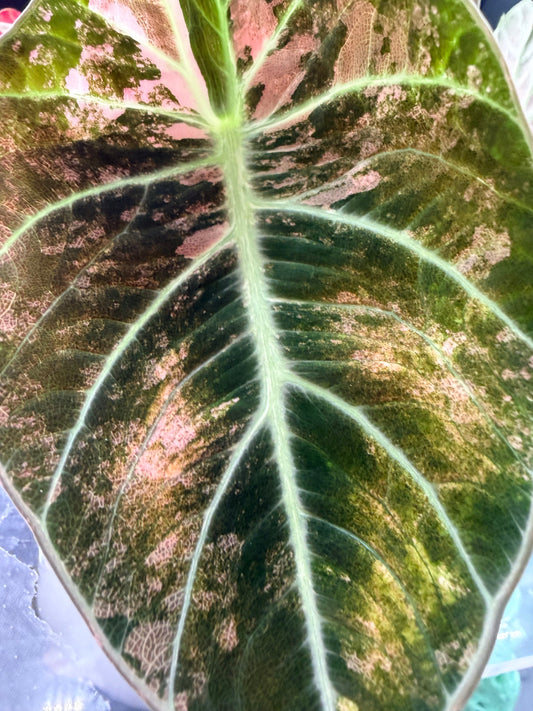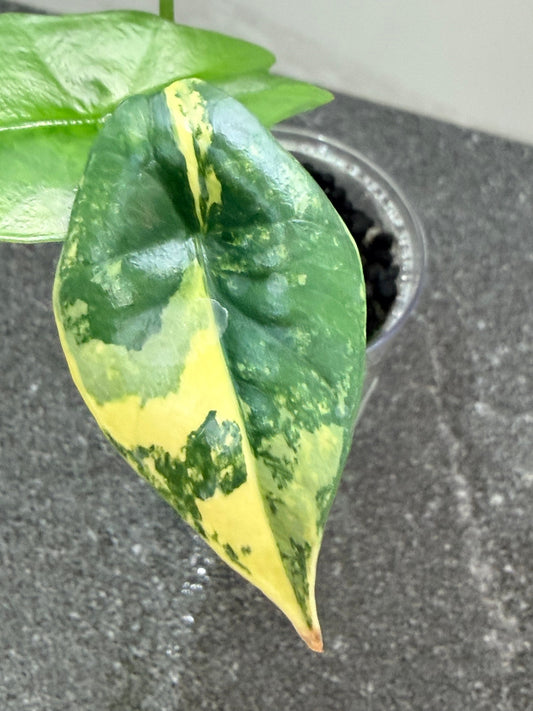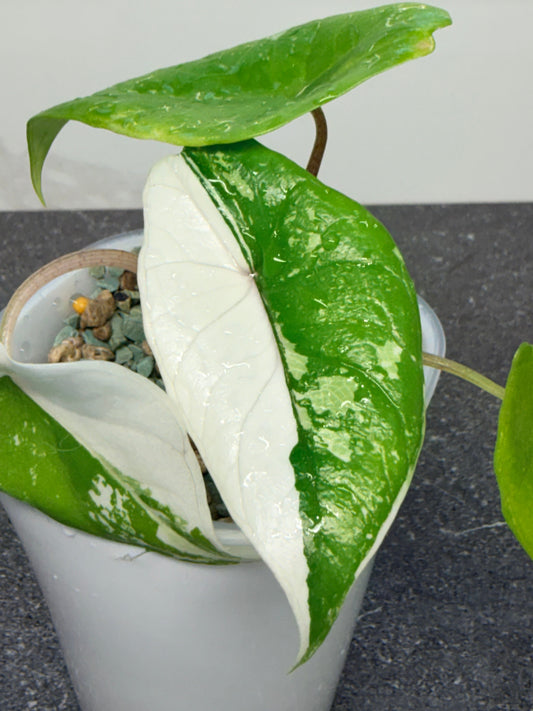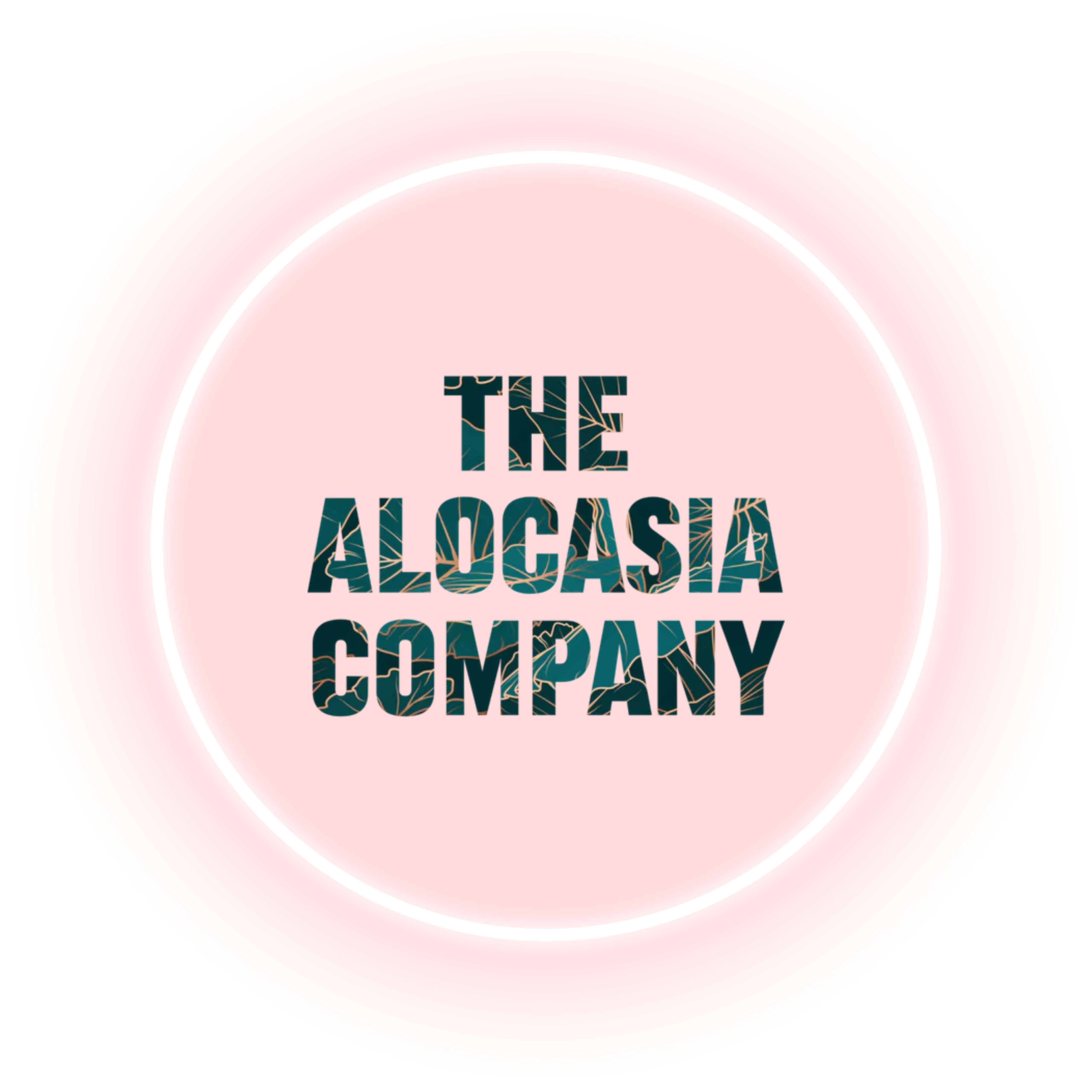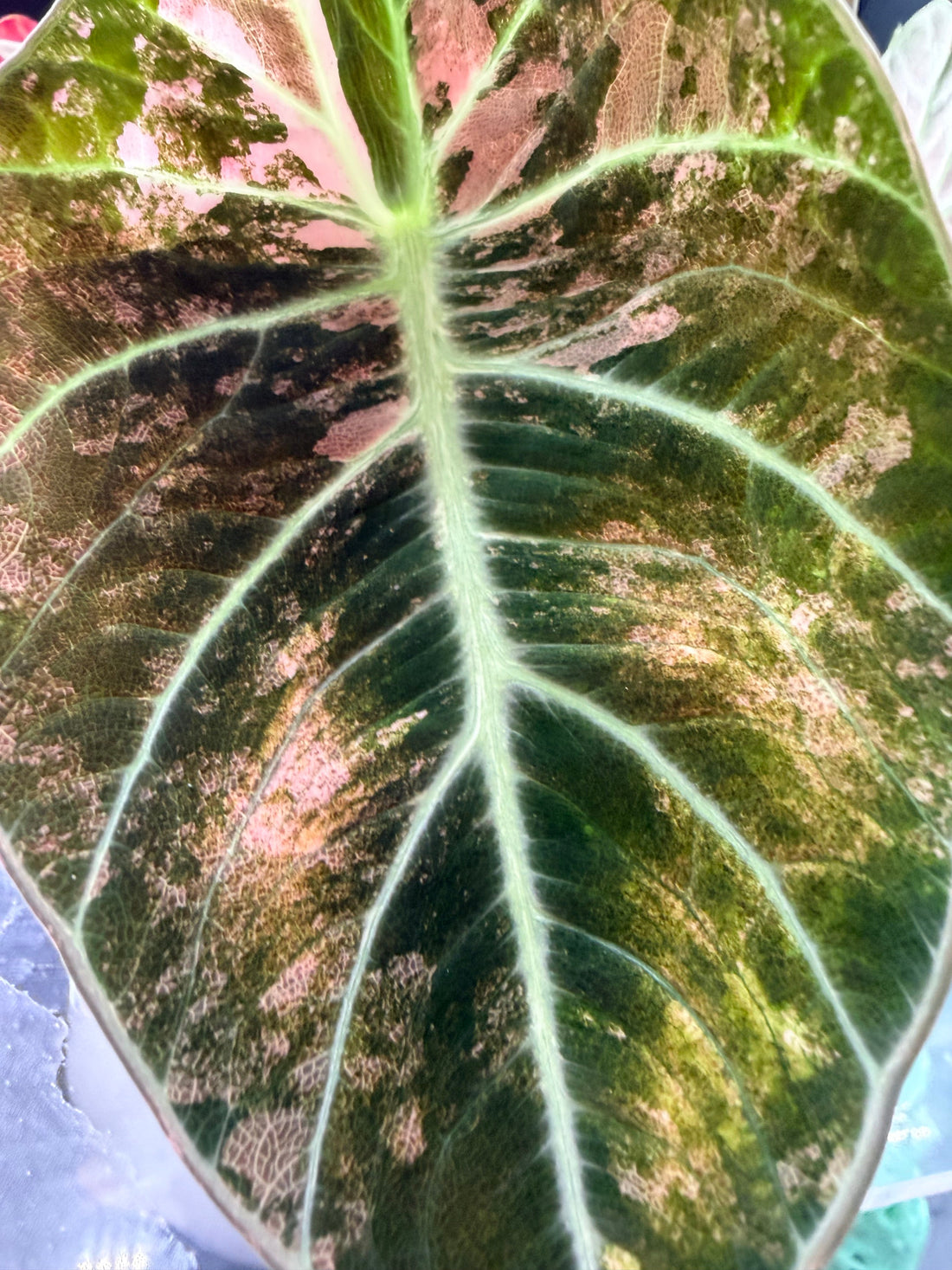
Complete Guide to Alocasia Variegation Types
Share
Complete Guide to Alocasia Variegation Types: Understanding Gold, Mint, Marble, and More
Variegation in Alocasia plants represents one of the most captivating phenomena in the plant collecting world. From pristine whites to blushing pinks, golden yellows to subtle mint greens, the diversity of variegation patterns has created an entire vocabulary of terms, nicknames, and classifications. In this comprehensive guide, we'll explore all the major variegation types found in Alocasia, explain the science behind each, and decode the common nicknames that collectors use.
Understanding Variegation: The Foundation
Before diving into specific types, it's essential to understand what variegation actually is. Variegation refers to the appearance of differently coloured zones on plant leaves, creating patterns that make each leaf unique. In Alocasia, this typically occurs due to genetic mutations affecting chlorophyll production—the green pigment responsible for photosynthesis.
The Core Science
Variegation in Alocasia primarily results from chimeric mutations. This means the plant contains two or more genetically different types of cells existing side by side—some that can produce chlorophyll and others that cannot. These mutations occur in the meristem (growing tips) where new cells form, and as the plant grows, it creates a mosaic of different cell types, resulting in those stunning patterns we admire.
Why Variegation Exists
From an evolutionary standpoint, variegation is essentially a genetic quirk—a mutation that persists because humans find it beautiful and propagate these plants intentionally. In nature, heavily variegated plants would often be at a disadvantage since they have less chlorophyll for photosynthesis. But in our collections, this "flaw" becomes a prized feature.
The Three Primary Variegation Types
Albo Variegation: The Classic White
Albo variegation produces white, cream, or silver patterns on leaves. The term "albo" comes from Latin for white.
Scientific Explanation: Albo sections completely lack chlorophyll and other pigments. These areas cannot photosynthesize at all, making them purely ornamental zones that rely entirely on the green portions of the leaf for energy.
Common Nicknames:
- "Snow" or "Ice": Used for particularly bright white variegation
- "Silver": Especially for varieties like Okinawa Silver with translucent white sections
- "Half-Moon": When roughly half the leaf is white
- "Full-Moon": Rare leaves that are almost entirely white (these usually cannot survive long-term)
Popular Albo Varieties:
- Alocasia macrorrhiza Albo Variegata
- Alocasia longiloba albo
- Alocasia Sarian albo variegated
- Alocasia Melo albo variegated
- Alocasia Frydek variegated (white veining)
Key Characteristics:
- Pure white to cream coloration
- Cannot photosynthesise in variegated areas
- Most delicate and prone to browning
- More common than aurea but rarer than green-on-green patterns
For an in-depth look at albo variegation, see our article on [Albo Variegation in Alocasia].
Aurea Variegation: The Golden Treasure
Aurea variegation displays yellow, golden, and lime tones. "Aurea" means gold in Latin.
Scientific Explanation: Unlike albo, aurea sections lack chlorophyll but retain carotenoids (yellow-orange pigments). This means they're not completely pigment-free and can contribute minimally to photosynthesis.
Common Nicknames:
- "Gold" or "Golden": Standard term for yellow variegation
- "Lemon": Bright, clear yellow tones
- "Lime": Yellow-green variegation
- "Butter": Creamy, soft yellow tones
- "Sunshine": Vivid, warm yellow patterns
Popular Aurea Varieties:
- Alocasia macrorrhiza Aurea Variegata
- Alocasia odora 'California Variegata Aurea'
- Alocasia gageana aurea
- Alocasia Black Velvet Gold Aurea Variegata
- Alocasia Azlanii Pink Aurea (combination type)
Key Characteristics:
- Yellow to golden coloration
- Retains some pigments (carotenoids)
- Slightly hardier than albo
- Genetically rarer than albo
Explore more about this rare form in our article [Aurea Variegation in Alocasia].
Pink Variegation: The Romantic Illusion
Pink variegation shows rose, blush, or lavender tones on leaves.
Scientific Explanation: Here's the fascinating part: pink variegation isn't actually pink pigment! It's chlorophyll-free areas allowing the natural purple-red anthocyanins (present on leaf undersides) to show through, creating a pink appearance to our eyes.
Common Nicknames:
- "Pink" or "Blushing": Standard terms
- "Rose": Deeper pink tones
- "Lavender": Purple-pink hues
- "Flamingo": Bright, vibrant pink
Popular Pink Varieties:
- Alocasia Bambino Pink Variegated
- Alocasia Watsoniana Pink Variegated
- Alocasia cuprea 'Red Secret' Pink Variegata
- Alocasia Yucatan Pink Variegated
- Alocasia reginula 'Black Velvet' Variegata (can show pink tones)
Key Characteristics:
- Pink to lavender appearance
- Results from anthocyanins showing through
- Only occurs in varieties with purple undertones
- Often intensifies in brighter light
Learn more in our detailed guide: [Pink Variegation in Alocasia].
Secondary and Specialty Variegation Types
Mint Variegation: The Subtle Beauty
"Mint" refers to pale green, minty, or cream-green variegation that's softer than pure white but not quite green.
Scientific Explanation: Mint variegation represents an intermediate state where cells have severely reduced chlorophyll but not a complete absence. They contain some green pigment, just much less than normal tissue.
Common Characteristics:
- Pale green to cream-green appearance
- Softer, more muted than albo
- Can be combined with white sections
- Creates a marbled, watercolor effect
Popular Mint Varieties:
- Alocasia cucullata 'Mint'
- Alocasia Dragon Scale Mint
- Alocasia Regal Shield Albo Mint
- Alocasia odora 'California Variegata' (often described as having mint tones)
Nicknames:
- "Mint": Primary term for pale green variegation
- "Sage": Gray-green tones
- "Seafoam": Blue-green mint coloring
- "Cream": When mint is very pale
Marble Variegation: The Artistic Pattern
"Marble" or "marbled" describes the pattern rather than the color—irregular, swirled mixtures creating a marble-like effect.
Pattern Characteristics:
- Random, unpredictable swirls and streaks
- Multiple colors mixed throughout the leaf
- No clear sectoral divisions
- Each leaf dramatically different
Common in These Varieties:
- Alocasia Dragon Scale varieties (mint, silver marbling)
- Alocasia macrorrhiza variegates (often marble patterned)
- Alocasia gageana varieties
Nicknames:
- "Marble" or "Marbled": Standard descriptors
- "Splash": Random splashes rather than sections
- "Speckled": Small marble-like spots
- "Watercolor": Soft, blended marbling
Sectoral Variegation: The Bold Blocks
Sectoral variegation refers to large, distinct sections of different colors on a single leaf.
Pattern Characteristics:
- Clear divisions between colored zones
- Often geometric or blocky appearance
- Can include half-moon or quarter-moon patterns
- More stable and predictable than splash patterns
Common Sectoral Patterns:
- "Half-Moon": One half variegated, one half green
- "Quarter-Moon": About 25% variegated
- "Three-Quarter-Moon": About 75% variegated
- "Sectoral": Multiple clear sections
Reflective or Blister Variegation: The Metallic Shine
This type isn't true variegation but is often confused with it. It's caused by air pockets between leaf layers creating a reflective, silvery appearance.
Examples:
- Alocasia Frydek (silvery veins)
- Alocasia Dragon Scale (natural silver tones)
- Alocasia zebrina (reflective patterns)
Key Difference: This is natural to the plant species, not a genetic mutation, so all plants of that variety show this trait.
Understanding Common Variegation Nicknames
The plant community has developed a rich vocabulary of nicknames for variegation patterns. Here's your decoder:
Color-Based Nicknames
White Family:
- Albo: Official term for white variegation
- Snow/Ice/Frost: Very bright white
- Silver: Slightly translucent white or gray-white
- Cream: Off-white, warmer tones
- Pearl: Iridescent white
Yellow Family:
- Aurea: Official term for yellow/gold
- Gold/Golden: Standard yellow
- Lemon: Bright, clear yellow
- Butter: Soft, creamy yellow
- Lime: Yellow-green
- Sunshine: Bright, warm yellow
Pink Family:
- Pink: Standard term
- Rose/Blush: Deeper, richer pinks
- Flamingo: Bright, vibrant pink
- Lavender: Purple-pink
- Confetti: Mixed pink and white
Green Family:
- Mint: Pale, muted green
- Sage: Gray-green
- Lime: Yellow-green
- Seafoam: Blue-green
Pattern-Based Nicknames
Sectoral Patterns:
- Half-Moon: ~50% variegated
- Full-Moon: Nearly all variegated
- Quarter-Moon: ~25% variegated
- Sectoral: Clear sections
Splash Patterns:
- Marble/Marbled: Swirled, mixed
- Splash: Random splotches
- Speckled/Spotted: Small spots
- Flecked: Tiny marks
Distribution Patterns:
- Constellation: Small, star-like spots (popularized by Thai Constellation Monstera)
- Confetti: Many small, scattered spots
- Streaked: Linear variegation
- Blocky: Large, geometric sections
Multi-Color and Combination Variegation
Some exceptional Alocasias display multiple types of variegation simultaneously, creating particularly stunning specimens.
Tri-Color Variegation
Plants showing three distinct colors on a single leaf:
- Green + White + Pink
- Green + Yellow + White
- Green + Cream + Mint
Examples:
- Alocasia Azlanii Pink Aurea (green, pink, yellow)
- Some Alocasia cuprea 'Red Secret' (green, pink, white)
The "Rainbow" Effect
When plants show multiple variegation types or particularly complex patterns, collectors sometimes call them "rainbow" or "tri-color," though this is informal terminology.
Geographic and Commercial Naming
The "California" Line
Several variegated Alocasias carry the "California" designation:
- Alocasia odora 'California Variegata'
- Alocasia odora 'California Variegata Aurea'
This refers to a cultivar line, not the colour or pattern type.
The "Okinawa" Distinction
"Okinawa Silver" refers to specific silver-white variegated Alocasia odora with more translucent white sections and intense stem striping, distinct from cream-yellow variegated odoras.
Trade Names vs. Scientific Names
Be aware that many "names" are actually descriptive nicknames:
- "Mint" might be added to any variety showing pale green variegation
- "Albo" or "Aurea" indicates the variegation type, not necessarily a specific cultivar
- Geographic names (Thai, California, etc.) sometimes indicate origin, sometimes are marketing names
The Instability Factor: Why Patterns Change
All chimeric variegation (albo, aurea, pink) is inherently unstable. Your plant may:
Produce Variable Leaves:
- Heavily variegated one month
- Mostly green the next
- Occasionally all-variegated (often unsustainable)
Revert Completely:
- Start producing only green leaves
- Lose variegation permanently in certain sections
- Can sometimes be encouraged back with proper care
Why This Happens:
- Random cell division creates unpredictable patterns
- Environmental stress can trigger more green growth
- The plant prioritizes survival (green) over aesthetics (variegated)
Caring for All Variegation Types
While specific needs vary slightly, general care principles apply to all variegated Alocasias:
Light Requirements
- Bright, indirect light for all types
- More light = healthier expression of variegation
- Never direct sunlight on variegated sections
- LED Grow Lights from our store provide consistent illumination
Humidity and Temperature
- 60-80% humidity ideal
- 18-27°C (65-80°F) temperature range
- Avoid cold drafts and sudden changes
- Use humidifiers in dry seasons
Watering
- Keep soil consistently moist, never soggy
- Allow top 2-5 cm to dry between waterings
- More variegation = more careful watering needed
- Room temperature water only
Fertilization
- Half-strength balanced fertilizer
- Monthly during growing season
- Reduce or stop in winter
- Variegated plants need less feeding than green varieties
Soil
- Well-draining aroid mix
- Orchid bark + perlite + peat/coco coir
- Good aeration crucial
- Consider activated charcoal
For detailed information on starting from corms, see our guide: [How Long Does It Take for a Corm to Sprout?].
Propagation: Maintaining Variegation
All chimeric variegation requires vegetative propagation to maintain:
Methods:
- Division: Separate rhizomes with growth points
- Corms: Baby bulbs produced by mother plant
- Never seed: Variegation doesn't pass through seeds
Best Practices:
- Propagate in spring during active growth
- Select most heavily variegated sections
- Ensure each division has active growth point
- Maintain high humidity during establishment
If you want to start a corm journey with variegated varieties, try our Corm Starter Kit with three mystery corms!
The Value Hierarchy
Understanding why certain variegation types command different prices:
Most Expensive (Generally):
- Stable aurea (rarest mutation)
- Multi-color combinations
- Heavy sectoral albo (half-moons)
Mid-Range: 4. Pink variegation 5. Standard albo 6. Stable mint patterns
More Accessible: 7. Light splash variegation 8. Reflective "variegation" (natural to species)
Factors Affecting Value:
- Genetic rarity
- Stability of variegation
- Growth speed and ease
- Current market demand
- Aesthetic appeal
Common Challenges Across All Types
Browning Variegated Sections
- Cause: Low humidity, direct sun, or inconsistent watering
- Solution: Increase humidity, adjust light, stabilize watering schedule
Fading Variegation
- Cause: Insufficient light or natural leaf aging
- Solution: Gradually increase light intensity (while keeping indirect)
Reversion to Green
- Cause: Genetic instability plus environmental stress
- Solution: Increase light, prune reverted sections, optimize care
Slow Growth
- Cause: Reduced chlorophyll = slower energy production (normal)
- Solution: Be patient, provide optimal conditions, feed appropriately
Building Your Variegated Collection
For Beginners: Start with more stable, less expensive varieties:
- Alocasia Frydek (natural reflective "variegation")
- Light splash albo varieties
- Alocasia Polly (distinctive veining)
For Intermediate Collectors: Progress to true chimeric variegation:
- Standard albo varieties
- Pink variegation
- Mint patterns
For Advanced Collectors: Seek rare and challenging types:
- Aurea variegation
- Multi-color combinations
- Heavy sectoral patterns
- Rare species with variegation
Final Thoughts
The world of Alocasia variegation is incredibly diverse, spanning from pure whites to golden yellows, blushing pinks to subtle mints. Understanding the science behind each type—whether it's complete pigment absence (albo), selective pigment retention (aurea), or anthocyanin expression (pink)—helps us appreciate these plants on a deeper level.
The rich vocabulary of nicknames and terms used by collectors reflects the passion and creativity of the plant community. Whether you call it "marble," "mint," "gold," or "half-moon," each term describes a unique expression of genetic variation that makes these plants so captivating.
While variegated Alocasias demand more attention than their solid green cousins, the reward is living artwork that changes and surprises with every new leaf. From the stark drama of albo to the warm glow of aurea, from the romantic blush of pink to the subtle sophistication of mint—there's a variegation type to capture every collector's heart.
For more detailed information on specific variegation types, explore our companion articles: Albo Variegation in Alocasia, Pink Variegation in Alocasia, and Aurea Variegation in Alocasia. Together, these guides provide everything you need to understand, appreciate, and successfully grow these remarkable plants.
Whether you're just beginning your variegated Alocasia journey or expanding an established collection, understanding the science and terminology empowers you to make informed decisions and provide the best care. Each variegated Alocasia is unique—a living canvas painted by genetic mutation and nurtured by dedicated care. Welcome to the fascinating world of variegation, where science meets art in the most spectacular way.

